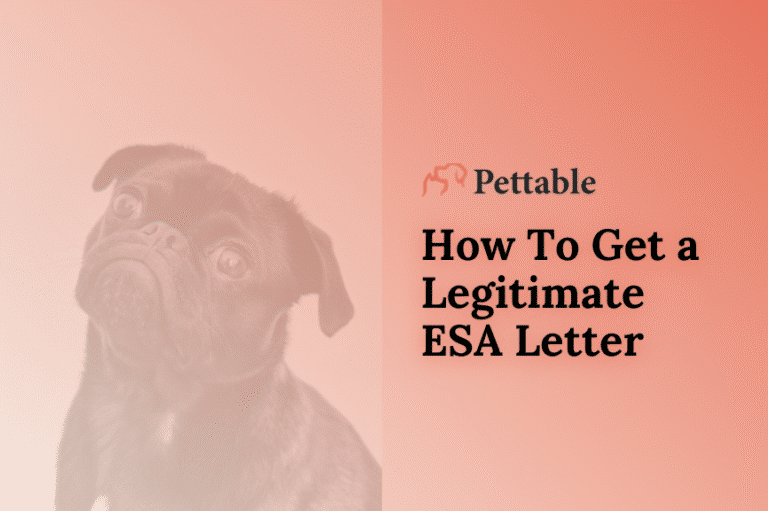How to Make My Dog an Emotional Support Dog: A Complete Guide to ESAs

For many of us, life without our furry friends would be unimaginable. That’s why it can be so heartbreaking when it seems like building after building has a “no dogs allowed” rule.
The good news? If your dog is a crucial part of your mental health support system, then you may be able to make your dog an emotional support animal (ESA). If your dog successfully becomes an emotional support animal, then it becomes far easier for your ESA to share a home with you. In this article, we will discuss what an emotional support dog (ESD) is, the qualifications you need to have to obtain an ESD, and lastly, how to make your pet an emotional support dog.
Bottom line:
- What is an emotional support dog? – an emotional support dog provides comfort and support through its mere presence.
- Do I qualify for an emotional support dog? – if you suffer from a mental and emotional disability then there’s a good chance that you also qualify for an emotional support dog. See if you qualify today.
- How to make my dog an emotional support dog – by obtaining a emotional support animal letter from a licensed mental health professional, your dog can become an ESD.

What is an emotional support dog?
First things first: what is an emotional support dog? It’s important to keep in mind that an emotional support dog is no ordinary pet. These assistance animals provide comfort, support, and companionship to their owners through their mere presence. While all dogs have an emotional connection with their owners, an emotional support dog is meant to provide therapeutic benefits to those suffering from a mental or emotional disability. Under the Americans with Disabilities Act (ADA), a disability is defined as a physical or mental impairment that substantially limits one or more major life activities, a person who has a history or record of such an impairment, or a person who is perceived by others as having such an impairment.
Housing accommodations for individuals who use emotional support dogs
While emotional support dogs do not have the same rights as service animals, they are protected under the Fair Housing Act. The Fair Housing Act was established to prevent landlords and building owners from discriminating against tenants, including tenants with disabilities. Renters with emotional support animals are protected and have special rights under this federal law. This means, that landlords must make accommodations for emotional support dog owners, even in buildings with a “no-pet policy” with an ESA letter for housing. Additionally, because an emotional support dog is not a regular pet, no pet-related rules in the building will apply to your ESD. Emotional support dogs are waived of any pet-related fees, pet deposits, as well as any breed restrictions. For example, even if a building’s policy prohibits Pitbulls, the housing provider must still accommodate your emotional support dog.
Service dogs vs. Emotional support dogs
A service dog and an emotional support dog are two different types of assistance animals that are often confused for one another, however, there are a lot of differences between the two. Since 2011, dogs are the only animal recognized as service animals under the Americans with Disabilities Act (ADA). Unlike ESDs, service dogs must be trained to perform specific tasks that help their handlers with their physical or mental disability. Lastly, service dogs have far more rights than emotional support animals do. Emotional support animals are only granted special rights and privileges regarding housing. On the other hand, a service dog, service animal, or a psychiatric service dog is allowed in all public places including grocery stores, restaurants, and airplanes.
While emotional support animals are most commonly dogs, they don’t have to be. Any animal that provides therapeutic value can be considered an emotional support animal. Other common types of emotional support animals include cats, hamsters, and in some cases, miniature horses. However, dogs are the most common type of emotional support animal for a reason. If your ESA is too hard to make reasonable accommodation for, a landlord has grounds to reject your ESA. Unlike service dogs, emotional support animals are not required or expected to perform specific tasks related to their owner’s condition, nor must they adhere to any behavior standards or training. That being said, you will want your ESD to be generally well-behaved, as this may impact your ESD’s housing rights.
Do I qualify for an emotional support dog?
If you are struggling with a mental or emotional disability that substantially limits one or more major life activities then there’s a good chance that you also qualify for an emotional support dog. There is no list of mental and emotional disabilities that one must possess to qualify for an emotional support dog. Ultimately, the decision of whether you qualify for an ESD or not is in the hands of mental health professionals. However, here are some common disabilities that people with ESDs typically struggle with.
- Certain phobias
- Grief
- Post Traumatic Stress Disorder (PTSD)
- Obsessive-Compulsive Disorder (OCD)
- Depression
- Anxiety
- Emotional Challenges
- Learning disorders
- Attention Deficit Disorder (ADD)
- Motor Skills disorders
- Bipolar disorder
- Substance-related disorder
- Cognitive Disorders
How to make your dog an emotional support dog
Many people use the term “certifying a dog” when it comes to making your pet an emotional support dog. However, this is not exactly the correct terminology. There is no such thing as a certificate or a certification program that legally qualifies a dog as an emotional support animal. To make your pet an emotional support dog, and legally live with your dog in pet-prohibited housing, you only need one document: an emotional support animal letter. Also known as an ESA Letter, an emotional support animal letter is an official document that has the signature and approval of a licensed mental health professional. This document certifies that your animal is necessary for your emotional support as part of your mental health treatment. In this section of the article, we will walk you through this process step by step.
Match with a licensed mental health professional
A licensed mental health professional includes a wide variety of skilled practitioners including psychologists, counselors, clinicians, therapists, clinical social workers, psychiatrists, primary care physicians, family nurse practitioners, and more. If you are already seeing a psychiatrist or therapist, this is going to be the person to consult with regarding an emotional support dog. If your psychologist deems that you qualified for an ESD, then your mental health professional will be able to prescribe you an ESA Letter.
While many mental health professionals are legally permitted to write ESA letters, not every therapist or psychologist is an expert in the matter. If your current therapist is unable to write you an ESA letter themselves, they will most likely be able to recommend someone who can. Additionally, if you are not currently seeing a therapist, numerous online ESA services are also able to provide you with a valid ESA Letter.
Consult with an LMHP
Once you have matched with a mental health professional, either online or in-person, your licensed therapist will evaluate you and confirm whether or not you are eligible for an emotional support dog.
If you are indeed eligible for an ESD, you will then receive an emotional support animal letter. If you are using an online service, some companies guarantee that you will receive your emotional support animal letter within 24 hours of your consultation.
Show your ESA letter to your landlord
After you have received a virtual or hard copy of your ESA letter, you can then present your landlord with the document. Legally, you are allowed to present your landlord with this document before or after you have signed your lease. Under the Fair Housing Act, your landlord cannot evict you for owning an emotional support dog. However, if you want to establish good and positive relations with your landlord, it is best to be upfront about your situation as soon as possible.
Most landlords are very understanding of people’s needs for emotional support dogs and are willing to comply with federal law. If your landlord confirms that they can make reasonable accommodation for your ESD, then you should have no issues. Additionally, while your landlord cannot request any extra paperwork from your regarding your emotional support dog, they can check the legitimacy of your ESA Letter.

What Dog Breed Is Best for Emotional Support?
There is no one “best” breed of dog for emotional support, as each individual’s needs are different. However, some breeds may be better suited for emotional support work than others. For example, dogs known for being calm, gentle, and loving may be ideal emotional support animals.
Breeds such as Labrador Retrievers, Golden Retrievers, Cavalier King Charles Spaniels, and Poodles are oftensuitable for emotional support dogs, especially when dealing with depression. It is essential to choose a dog breed that fits your lifestyle and personality and supports the issues you are facing, as this will make it easier for you to bond with your animal.
When choosing an emotional support dog, it is crucial to consider the animal’s temperament, as this can play a significant role in how well the animal will be able to perform its job. Animals that are high energy, easily excited, or prone to barking may not be ideal for emotional support work.
Size is another important consideration when choosing an emotional support dog. Some people prefer smaller dogs because they are easier to care for and take with them on trips. Other people prefer larger dogs because they provide security and safety. Ultimately, the best emotional support dog is the one that is the best fit for you and your needs.
How Much Does It Cost To Register An Emotional Support Animal?
The emotional support animal letter is the only document you need to have an emotional support dog. There is no extra cost or fee for the document. That said, mental health professionals may charge a consultation fee usually ranging from $100 to $150.
Additionally, while numerous online services can connect you with a licensed mental health professional, it is important to be aware that not all of these services are legitimate. Some companies may charge hidden fees or try to upsell you on additional products and services. Therefore, when seeking an emotional support animal letter, it is important to research and choose a reputable company.
Does Insurance Cover Emotional Support Dogs?
At this time, no federal law requires health or pet insurance companies to cover emotional support animals. However, this does not mean that your insurance companies will not cover some of the costs associated with having an ESD. Some pet insurance companies offer riders or add-ons that will help cover some of the costs of vet bills, prescriptions, and more.
It is always a good idea to contact your insurance companies directly to find out what assistance they can provide for emotional support animals.
As more and more people begin to realize the benefits of emotional support animals, there is a possibility that insurance companies will eventually be required to provide coverage for these animals.
How Can I Cover the Costs of Owning an Emotional Support Dog?
Even though most health insurance plans do not currently cover emotional support dogs, there are a few ways that you can offset the costs of owning an emotional support dog. These include:
- Social security benefits: If you are disabled and unable to work, you may be eligible for social security benefits. These benefits can help offset the costs and training and caring for an ESD.
- Grants: Several organizations offer grants to people with emotional support animals, which can be a great way to get financial assistance for vet bills, prescriptions, and more.
- Charity: There are existing charities that may help to cover the costs associated with having an emotional support animal
- Crowdfunding: There are several crowdfunding platforms that you can use to raise money for your emotional support animal, which is a great option if you need help with one-time or unexpected costs.
- Discounts: Several companies offer discounts to people who have emotional support animals, which includes things like pet insurance, food, toys, and more.
- Personal savings: This is probably the most common way that people cover the costs associated with having an emotional support animal. If you can, setting aside a small amount of money each month can help cover unexpected expenses.
No matter how you choose to cover the costs of having an emotional support animal, it is essential to remember that these animals can provide a wealth of benefits. So if you are considering getting an emotional support animal, but are worried about the costs, look into these options for help.
FAQs on Emotional Support Dogs
Can emotional support dogs fly?
As of January 2021, emotional support dogs are no longer considered to be service animals under the Air Carrier Access Act by the United States Department of Transportation (DOT). In previous years, too many people had tried to misrepresent their pets as ESAs. Thus, emotional support dogs are no longer granted the same public access on air carriers as service dogs are. Instead, airlines still recognize and accommodate emotional support animals as pets.
How much is an emotional support dog?
Unlike service animals, individuals cannot adopt certified emotional support dogs. Instead, an individual is prescribed an emotional support dog in the form of an emotional support letter. If you are already seeing a therapist, you will most likely not be charged an additional fee for an ESD. If you choose to use an online service, you will be charged a one-time fee for a therapist’s time.
What do emotional support dogs do?
Unlike service dogs, emotional support dogs are not individually trained to perform tasks. Instead, they provide therapeutic benefits simply through companionship. Through their mere presence, emotional support dogs can lower anxiety, alleviate loneliness, enhance social engagement and interaction, normalize heart rate and blood pressure, and reduce stress and depression.
Can emotional support dogs go anywhere?
Except for housing, emotional support dogs are not allowed anywhere where regular pets are not allowed. Unlike service animals, emotional support dogs are not allowed in restaurants, grocery stores, shops, or on airplanes. If your ESD is well-behaved, some businesses may make an exception for your emotional support dog.
Can any dog be an emotional support dog?
Any breed of dog can be an emotional support dog – the most important aspect to consider is the connection between the dog and the owner. If you are looking on buying or adopting a new dog, there are many calm dog breeds with easy-going personalities such as Cavalier King Charles spaniels, Labrador retrievers, corgis, and poodles.
Can a landlord refuse an emotional support dog?
In most cases, a landlord must make reasonable accommodation for emotional support dogs, however, there are some circumstances where your landlord is legally allowed to reject your ESA. If your ESA letter is illegitimate or older than one year, a landlord can reject your emotional support dog. If your ESD is a threat to the health or safety of others, then your landlord may also reject your ESD.
Can you get an emotional support dog for anxiety?
Yes, many people who suffer from anxiety have qualified for emotional support dogs. Anxiety is one of the common mental illnesses that ESA owners suffer from. If your licensed therapist deems that an emotional support dog is vital to helping you maintain a mentally healthy life, then you will qualify for an emotional support dog.






